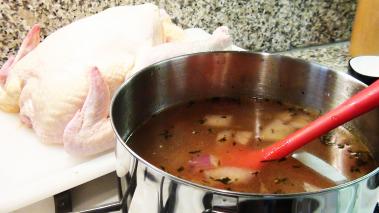How to Brine
Learning how to brine will benefit you not just for the Thanksgiving Turkey, but throughout the year. And fortunately, it is so simple, that with a quick read, and a view my “How to Brine” video, you’ll have it mastered in no time. With a good brine your recipe (whether it be pork, chicken or seafood) will turn out more tender, more juicy and more flavorful. So...why not start brining?
What is a brine? And How does it work?
Before learning how to brine, let’s first talk about how brining works, and what it does. Brines themselves are really nothing more than Salt dissolved in water. For cooking purposes, additional flavors are frequently added to the salt/water mixture in the form of sugar, herbs, spices, vegetables…and just about anything else. These additional ingredients, flavor the brine itself, and as the brine moves into the meat, those flavors are carried along with it.
Now I’m no scientist, so forgive any minor errors in language or detail, but fundamentally brines work via the process of Osmosis – which is the transfer of liquid (in this case the brine) into and out of cells. When meat in placed in brine, the cells in the muscle tissue are less salty than the water itself. That makes sense. Through Osmosis, this imbalance corrects itself, and the cells absorb salt from the water, becoming more salty (which also creates move flavor). Because the cells now have more salt, a second reaction happens that causes them to absorb water from the brine, becoming more moist. All the while, any additional flavors you’ve added to brine are coming along for the ride. So what you end up with is a more flavorful, more moist cut of meat.
What should I brine?
While you can experiment and brine just about anything, most commonly, I brine fowl (Turkey & Chicken) and Pork. It’s not a coincidence that all are leaner meats. Fattier cuts, like beef, typically don’t benefit as much from a brine.
How to Brine
A good ratio for most brines is:
- 1/2 cup of sugar
- 1/2 cup of salt
- 2 quarts of water
To that basic brine, you can add all kinds of great flavors…onions, carrots, celery (all cooked or raw), peppercorns and other spices like allspice, cumin, coriander, and/or herbs like rosemary, thyme, fennel seed.
It’s important to make sure the salt and sugar are fully dissolved, so you may want to start with warm or hot water. If so, let the water cool before adding any meat. Put the brine in a sealed container or bag, and then add the chicken, turkey, pork, whatever you’ve got….make sure the meat is fully submerged. Then refrigerate the meat, and brine it for at least 5 hours, less and it really doesn’t have time to work….and up to a couple days. Provided you can keep everything properly refrigerated for that long.
Remove the meat from the brine. pat the surface dry, and allow it come up to room temperature before cooking, via your preferred method. And don’t forget, just because you brined, doesn’t mean you can skip the salt and pepper on the outside of the meat.
Now that you know how to brine, take a look a couple of my favorite brine recipes, and I wish you the best of luck!

Comments (20 )